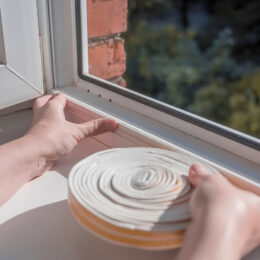by James Dulley

These are double-cell light-blocking cellular shades. They slide in tracks on the sides to reduce air flow and drafts from the cold window glass — and they look elegant in any application. Photo by Cellular window shades.
When it’s cold out, my home feels very chilly, especially near the windows. I can’t afford energy-efficient replacement windows right now, so can you offer alternative options?
If you feel chilly sitting near a window, you’re likely losing energy, which drives up your utility bills. This is also true during the summer when heat transfers in and forces your air conditioner to run longer. If replacement windows will exceed your budget, window shades are a reasonably priced option that will help.
Remember to caulk and weather strip your windows before making any other window efficiency improvements. Move a stick of lighted incense near all gaps and watch the trail of the smoke to find air leaks. Do this during windy weather, or briefly switch on an exhaust fan to draw outdoor air in through the gaps.
Installing insulated window shades will provide the most improved comfort and energy savings year-round. Several years ago, I installed Warm Window shades with a R-6 insulation value in my home office. This increased the overall R-value from R-2 to R-8 and improved comfort.
When selecting insulated window shades, there are important factors to consider such as the R-value, how well they seal when closed, ease of operation and appearance. Before you make a purchase, try to operate a sample insulated shade that’s similar in size to your needs. If the shade is difficult to open and close, you are less likely to use it as often as you should.
Most commercially available window shades list the R-value on the packaging. They typically include some type of air barrier sewn inside the shade to block air flow through it. An aluminized or other type of low-emissive film is best to help block the radiant heat transfer through the shade.
There should be deep vertical tracks, which mount on the sides of the window opening, for the edges of the shade material. Deeper tracks create a longer path for air leakage to travel, so they provide a better seal. Adhesive-backed vinyl tracks are often included with the shades. Also, look for brush or foam weather stripping on the bottom edge where it rests on the windowsill when closed.
If you buy insulated shades that do not have vertical tracks, it is possible to make your own. Buy long pieces of aluminum U-channel. Most home center stores carry them in the hardware aisle. Stick them to the wall with a strong double-sided tape, or drill small holes and mount them with screws. Aluminum is easy to saw to length and easy to drill.
Cellular shades are a less expensive option and are best to use where you want some natural light to get through. The double-cell shades create an additional air gap for better insulation. Since their width grows as they are pulled up and collapsed, side channels are not very effective with this option.
The most common type of do-it-yourself window shade is a Roman shade design. The key to efficiency is to make them as thick as possible, while still being able to fold them up when opened. Include a reflective air barrier between the center layers. Reflective Mylar film works well for this and is very flexible.
James Dulley is a nationally syndicated engineering consultant based in Cincinnati. If you have a question about energy use or energy-efficient products, send it to: James Dulley, Electric Consumer, 6906 Royalgreen Drive, Cincinnati, OH 45244; or visit www.dulley.com.



